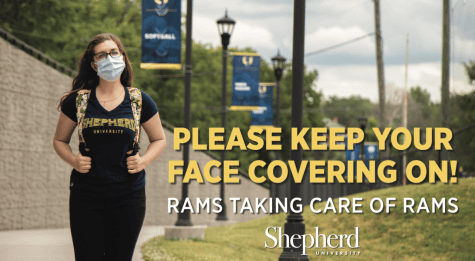SHEPHERDSTOWN, W.Va., – Gone are the packed lecture halls, frat parties, tailgating, and popping in and out of your professor’s office looking for clarity on the days lecture.
Replaced now with mask requirements, social distancing reminders, health screening forms, and the constant Zoom meetings. Even before classes began, students knew this year’s college experience was going to be different.

According to the Herald-Mail as of July 15, the Pennsylvania State Athletic Conference (PSAC), which Shepherd University is a part of, had canceled all fall sports competitions due to COVID-19 and are tentatively planning to hold them in the spring.
“I was preparing all summer. I was so excited to have my first fall season event. Surprise!
You’re not playing any tournaments this fall,” said Alexis Parrotte who is on the Shepherd golf team.
Classes were no different. After initially signing up for in-person classes in the spring, fall
courses were switched to hybrid over the summer, allowing for more classes to be online.
According to the Washington Post, as of early September, only 34 percent of 1,442 four-year colleges and universities were teaching in person, while 37 percent were teaching online.
The rest of the Universities took a combined approach like Shepherd, giving the availability to adapt to a changing situation. That flexibility has worked out in helping to keep everyone at a distance, but it comes with challenges, especially for ones that require hands on participations.
“It’s very difficult to have a field-oriented class online,” said Dr. Peter Vila, who is teaching his Limnology and Hydrology classes, as well as class labs, in person.
Though, teaching in person classes has its challenges given the new guidelines, “trying to make sure that you maintain the distance,” and “to have the capability to disseminate the information on how it is used is a little more difficult,” Dr. Vila said.
These challenges not only affect the professors who are teaching the classes, but the students as well.
Parrotte said, “It’s harder to have discussions with masks because you can’t hear as well, and I think it’s harder to connect with your teachers since you can’t go into their office a lot, only zoom meetings. And, like a lot of field trips you can’t have because of COVID-19. I just feel it’s not as hands-on.”
The adjustments to the new guidelines have led to frustrations and a new normal way of doing things with less distractions and more emphasis on the student’s responsibilities.
Dr. Vila said that “…it’s just going to take a little bit more on the part of the student to actually want to know. That if they missed it, they should make sure ‘hey I missed this part; could you explain it.”
Though frustrating as this whole scenario is, some good can come from it as well. Dr. Vila said that “it makes you more precise on what you say, and how you say it, and when you say it, of course,” and that “I think what it emphasizes is how much I value interaction, and how important that is in order to get ideas across.”
If nothing else, when everything gets back to some semblance of normal again, we will have a new appreciation for our hygiene, “I think handwashing and stuff will stay,” according to Parrotte.

Leave a Reply